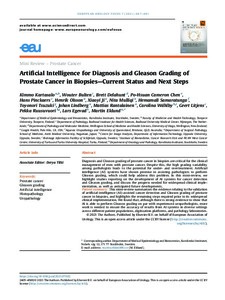Artificial Intelligence for Diagnosis and Gleason Grading of Prostate Cancer in Biopsies-Current Status and Next Steps
Pinckaers Hans; Wählby Carolina; Mulliqi Nita; Lindberg Johan; Egevad Lars; Litjens Geert; Ji Xiaoyi; Eklund Martin; Ruusuvuori Pekka; Olsson Henrik; Tsuzuki Toyonori; Kartasalo Kimmo; Chen Po-Hsuan Cameron; Bulten Wouter; Samaratunga Hemamali; Rantalainen Mattias; Delahunt Brett
https://urn.fi/URN:NBN:fi-fe2021102752717
Tiivistelmä
Diagnosis and Gleason grading of prostate cancer in biopsies are critical for the clinical management of men with prostate cancer. Despite this, the high grading variability among pathologists leads to the potential for under- and overtreatment. Artificial intelligence (AI) systems have shown promise in assisting pathologists to perform Gleason grading, which could help address this problem. In this mini-review, we highlight studies reporting on the development of AI systems for cancer detection and Gleason grading, and discuss the progress needed for widespread clinical implementation, as well as anticipated future developments.
Patient summary
This mini-review summarizes the evidence relating to the validation of artificial intelligence (AI)-assisted cancer detection and Gleason grading of prostate cancer in biopsies, and highlights the remaining steps required prior to its widespread clinical implementation. We found that, although there is strong evidence to show that AI is able to perform Gleason grading on par with experienced uropathologists, more work is needed to ensure the accuracy of results from AI systems in diverse settings across different patient populations, digitization platforms, and pathology laboratories.
Kokoelmat
- Rinnakkaistallenteet [27094]
